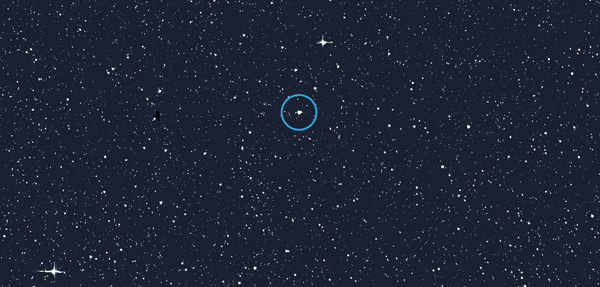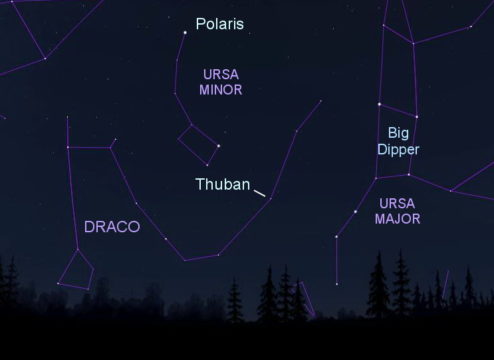The ancient pole star known as Thuban turns out to be an eclipsing binary. If you're up for a challenge, you can see the eclipses for yourself.

NASA / MIT / TESS
NASA's TESS mission has a primary goal of looking for exoplanets. But as it's examining stars for the subtle dips that mark a planet's passage in front of its star, it can catch lots of other stellar goings-on, too. At the recent American Astronomical Society meeting in Honolulu, astronomers announced that TESS had uncovered something rather surprising about the well-known double star in Draco named Thuban (also called Alpha Draconis). Turns out, the two stars eclipse each other as seen from Earth.
“The first question that comes to mind is ‘how did we miss this?’” says Angela Kochoska (Villanova University).
When two stars in a binary system eclipse each other, their overall brightness as seen from Earth fades and increases again in a cyclic way. Thuban's eclipses occur twice every 51.4 days. So even though Thuban isn't exactly the brightest star in the sky — at magnitude 3.7 it's the eighth-brightest star in Draco — the discovery at first took astronomers by surprise.
However, the primary eclipse causes a change in brightness of only about 0.1 magnitude; the secondary eclipse is marked by an even smaller dip, 0.02 magnitude. The variations are small in part because the stars don't fully eclipse each other. What's more, the eclipses are only six hours long. So perhaps it's no surprise that the small, brief dips in brightness were missed until now.
Even the space-based Kepler mission didn't catch the star's variations. Thuban was actually too bright for Kepler to look at without saturating its detector.
TESS, though, is designed to look at bright, nearby stars. The satellite monitors large swaths of sky for 27 days at a time, splitting each celestial hemispheres into 13 sectors each. Near the poles, these sectors overlap in what's termed the continuous viewing zone. These long observations with very precise measurements enabled TESS to find the subtle variations in Thuban's brightness.
Thuban, the Ancient Pole Star
Thuban is famous not for its brightness, but for the role it played in the Egyptian sky some 4,700 years ago: North Star.
Earth precesses, wobbling like a top as it spins, though its wobble takes 26,000 years to come full circle. So back when the Egyptians were just starting to build their pyramids, it was Thuban, not Polaris, that aligned with Earth's rotation axis.
As such, all the stars of the northern sky would have appeared to revolve around Thuban, giving it a place of celestial importance for ancient Egyptians, who may have aligned the Great Pyramids based on its position.
See for Yourself
While Thuban is known to be a binary, if you observe the system, you're really just observing the primary. This giant star is several hundred times brighter than the Sun, though dim in our view for being 300 light-years away.
The changes in Thuban's magnitude as it eclipses (and is eclipsed by) its smaller companion are small, as noted above. But if you're up for the observing challenge, Kochoska has calculated the times of the upcoming eclipses visible throughout 2020.
The table below gives the primary and secondary eclipses that occur in 2020. The bolded lines are observable from the North American Central Time Zone (CT) and/or the Central European Time Zone (CET); the lines in italics mark eclipses where an observer would miss the beginning but could still catch the end.
| Primary Eclipses | ||
| UTC | CST/CDT | CET/CEST |
| February 22, 2020 4:44 | February 21, 2020 22:44 | February 22, 2020 5:44 |
| April 13, 2020 14:48 | April 13, 2020 9:48 | April 13, 2020 16:48 |
| June 4, 2020 0:52 | June 3, 2020 19:52 | June 4, 2020 2:52 |
| July 25, 2020 10:56 | July 25, 2020 5:56 | July 25, 2020 12:56 |
| September 14, 2020 21:01 | September 14, 2020 16:01 | September 14, 2020 23:01 |
| November 5, 2020 7:05 | November 5, 2020 1:05 | November 5, 2020 8:05 |
| December 26, 2020 17:09 | December 26, 2020 11:09 | December 26, 2020 18:09 |
| Secondary Eclipses | ||
| UTC | CT/CDT | CET/CEST |
| February 9, 2020 5h:59m | February 8, 2020 23:59 | February 9, 2020 6:59 |
| March 31, 2020 16h:3m | March 31, 2020 11:03 | March 31, 2020 18:03 |
| May 22, 2020 2h:7m | May 21, 2020 21:07 | May 22, 2020 4:07 |
| July 12, 2020 12h:11m | July 12, 2020 7:11 | July 12, 2020 14:11 |
| September 1, 2020 22h:15m | September 1, 2020 17:15 | September 2, 2020 0:15 |
| October 23, 2020 8h:19m | October 23, 2020 3:19 | October 23, 2020 10:19 |
| December 13, 2020 18h:23m | December 13, 2020 12:23 | December 13, 2020 19:23 |
If you catch an eclipse, let us know in the comments!
 4
4










Comments
Yaron Sheffer
January 25, 2020 at 8:52 am
Personally, I believe these variations are too small for naked eye detections. But higher-tech amateurs might try to photometrically reproduce the light curve published in the original discovery paper by Bedding, Hey, and Murphy: https://iopscience.iop.org/article/10.3847/2515-5172/ab5112
You must be logged in to post a comment.
Lindhard
May 20, 2020 at 6:42 pm
Are these times given for mid eclipse or beginning?
You must be logged in to post a comment.
Monica YoungPost Author
May 26, 2020 at 11:44 am
The times listed are for mid-eclipse. Let us know if you're able to detect the variations!
You must be logged in to post a comment.
Lindhard
May 26, 2020 at 2:28 pm
Thanks.
We plan to try the Sep.14 eclipse.
You must be logged in to post a comment.
You must be logged in to post a comment.